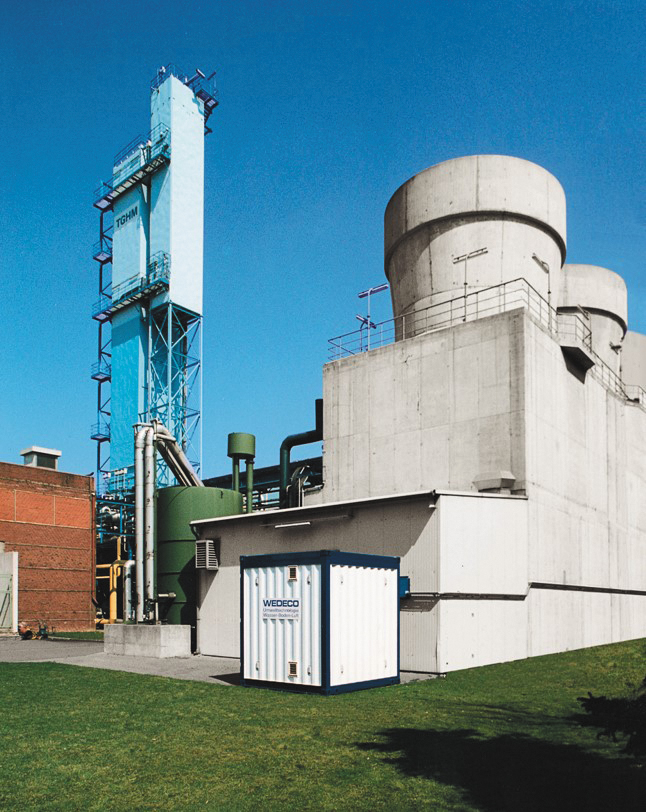ALEXIS MÉTAIS AND BRENDAN VAN WYK

Water is the preferred medium for the extraction of heat from exothermic processes, so cooling towers are an important means of ensuring efficient and reliable operation of industrial plants like pulp and paper mills. Cooling water circulates in a loop where heat is taken up from the process and then discharged in the cooling tower. In the cooling tower the circulating water is brought into direct contact with air and cooled through evaporation.
The draft caused by the cooling tower draws in dust and other organic material and creates an ideal growth environment for bacteria and algae. This bacterial growth within a cooling tower is a constant problem and, if left unchecked, will result in a thick biofilm growth, loss of cooling tower efficiency, and corrosion. This biofilm can also harbor pathogens such as Legionella, resulting in a toxic environment and public health risk.
To control this microbial activity, conventional treatment methods include biocidal chemicals. These need to be dosed in high enough concentrations to ensure a high log reduction of growth. Bacteria can build up immunity and tolerances to these chemicals, and so a routine change in chemicals and chemical dose is required. Conventional chemical treatment programs used to maintain a cooling tower in good operation consist of the following: biocide, anti-scale chemicals, corrosion inhibitors, defoaming agents, pH control, and dispersants.
The addition of all these chemicals and the removal of water through evaporation limits the amount of times the cooling water can be circulated before concentration of dissolved solids and chemicals becomes so high that scale can begin to form and become problematic. Therefore, some cooling water must be discharged (blowdown) and the basin water diluted with fresh water (makeup water). This blowdown needs to be treated in an effluent treatment plant before it can be discharged to the environment because of all the chemicals it contains.
Typical feed water and operating conditions usually limit the number of cycles of concentration to between two and five before scale becomes an issue, even with the pH correction. The cycles are controlled by discharging, or blowing down, the basin water and making up this water loss by adding fresh water. This control is normally done based on the water conductivity, so technicians must calculate a maximum conductivity. When this conductivity is reached, the blowdown valve is opened and the water is discharged to waste until a lower conductivity value is reached.
THE ROLE OF OZONE
Ozone (O3) can fulfil the role of most of the treatment chemicals. It is a gas with a strong oxidizing power produced from oxygen (O2). Because it self-decomposes rapidly into oxygen, ozone is produced on-site. There is no delivery, storage, or handling of chemicals and no remaining biocidal effect in the effluent discharge stream. Ozone is usually dosed through venturi injectors at 0.1-0.3 g/m3 depending on the cooling water quality. As an oxidizing biocide, ozone kills all microbes, such as bacteria, viruses, spores, and algae through cell lysis, rather than through poisoning like conventional biocides. This means that organisms cannot become immune to ozone, as so often happens with conventional biocides. Plus, contrary to chlorinated chemicals, ozone does not form AOX.
Ozone ensures that there is no microbial or bacterial growth within the water of the tower and removes any biofilm that may have been present before ozone was introduced, effectively cleaning up the full cooling water loop. Nalco1 reported as far back as 1992 “numerous case histories of the use of ozone in ‘zero discharge’ cooling tower applications” and operated a cooling system at a concentration of 100 cycles. Ferguson and Freedman2 reported that, in ozonated cooling waters of high calcium carbonate saturation ratios, when scale would be expected, calcium carbonate precipitates in the bulk water and not as scale. Indeed, the high biocidal efficiency of ozone avoids slime formation that could give opportunity for scale to appear, so calcium carbonate precipitates as crystals and then these crystals grow because of their own very high surface area. These precipitated crystals are easily removed in the system sand filters.
Pryor and Fisher3 also reported that “there have been numerous documented cases of ozonation systems operating for extended periods with zero intentional blowdown.” Actually, the use of ozone allows for increasing the cycles of concentration well beyond that predicted by the Langelier Saturation Index (LSI), so Pryor and Fisher developed the Practical Ozone Scaling Index (POSI) for cooling towers operated with ozone3.
The strong biocidal effect of ozone results in water savings since less blowdown and make-up water are required. Significant water savings were also reported more recently in other ozone treated cooling towers4, 5, 6. By increasing the cycles of concentration, there is a direct impact on the operating costs of the tower, through:
• Reduction in fresh water make-up
• Reduction in effluent discharge
• Lower need for equipment cleaning
• Higher efficiency of the heat transfer
A first consequence of scale not forming is that no anti-scale chemicals are required to be dosed into the tower. Since acid is normally dosed to maintain pH and avoid calcium carbonate precipitation, this is no longer required when using ozone because the calcium precipitates in a non-scaling manner.
As stated by Strittmatter, et al1, “the corrosion rate of mild steel is dominated by the saturation level of the water, and not by the presence or absence of ozone in the system.” So cooling water loops operated at high cycle of concentration (which is made possible due to the use of ozone) have minimal corrosion rates because of the high levels of dissolved metals and the subsequent reduction in the corrosion potential of the water. No corrosion inhibitor needs to be dosed.
Finally, since no chemicals are being added to the system, there is no foaming in the tower, and there is no need for the addition of dispersants to increase the solubility of chemicals, so no defoamers or dispersants need to be added to the system.
CASE STUDY
Here is a case study of a cooling tower with a circulation flow of 11,000 m3/h reducing temperature from 37°C to 30°C with an evaporation flow of 133 m3/h. Conventional chemical treatment, supplied by a cooling tower treatment services company, operates very well with 5.5 cycles of concentration. The required ozone dose is 0.3 g/m3 and ozone production requires a total of 12.5 kW/kgO3 including all the power used for the VSA to generate the oxygen as well as the power for ozone generation. At the end, both treatment solutions cost the same.
However, increasing the cycles of concentration to 15, which is made possible due to ozone, allows for a reduction in the make-up water flow rate from 163 m3/h to 143 m3/h, for significant savings.
Mills can expect further benefits related to the improved heat transfer efficiencies and energy savings associated with improved cooling of the process equipment; these would need to be calculated on a site-specific basis. Other cost and environmental benefits that need to be considered are the lower, or zero, AOX values in the effluent and the improved COD discharge to the effluent treatment plant.
In conclusion, cooling towers that are treated with ozone can expect the following benefits:
• Excellent cooling water quality, e.g., very good visibility depths
• Long-term protection against microbiological growth (bio fouling) because of a reduction of colony forming units CFU by approximately three to four log steps
• Effective control of Legionella
• Improved heat transfer
• Reduced waste water costs since COD levels are low and AOX values will be reduced because there are no chlorine or bromine additions
• Corrosion rates decreased as cycles of concentration increase
• Improved industrial safety due to no storage or handling of hazardous chemicals
• Operation at higher cycles of concentration
References:
1. Strittmatter, R.J., Yang, B. and Johnson, D.A., Application of Ozone in Cooling Water Systems, Corrosion’92, Nashville, TN, USA, (1992).
2. Ferguson, R.J. and Freedman, A.J., A Comparison of Scale Potential Indices with Treatment Program Results in Ozonated Systems, Presented at Corrosion’94, Houston, TX, USA, (1993).
3. Pryor, A. and Fisher, M., Practical Guidelines for Safe Operation of Cooling Tower Water Ozonation Systems, Ozone Science & Engineering, Vol. 16, pp. 505-536, (1994).
4. Van Wyk B.J., Full-Scale Pilot Investigation into Ozone Treatment for Cooling Tower Water, WISA Conference, Cape Town, South Africa, (2006).
5. Panjeshahi, M.H., Ataei, A., Gharaie, M., Parand, R., Optimum design of cooling water systems for energy and water conservation, Chemical Engineering Research and Design 87, Elsevier Ltd., (2009).
6. Gina, N., Effective and Efficient Ozone Use on Cooling Water Systems, MSc Dissertation, University of the Witwatersrand, South Africa, (2014).
Brendan van Wyk is business development manager, pulp and paper, at Xylem. Alexis Métais is pulp and paper key account manager, Xylem Inc., and can be reached at [email protected].
 Paper 360
Paper 360

